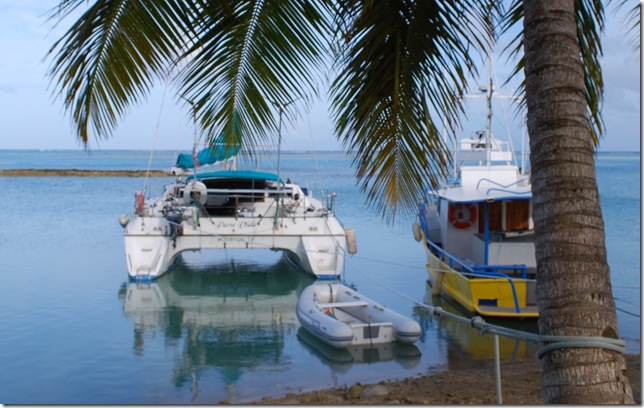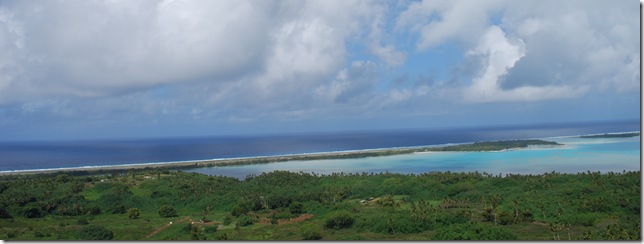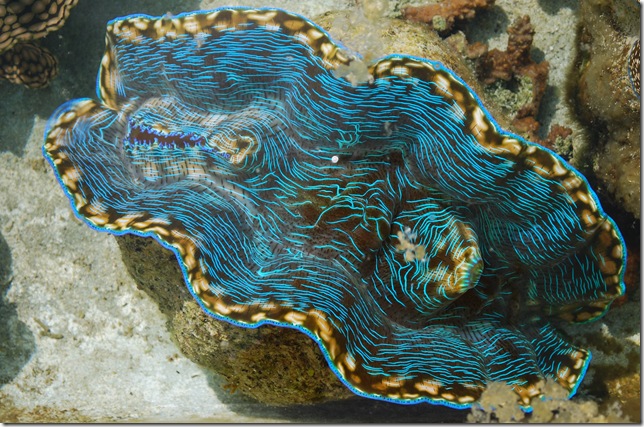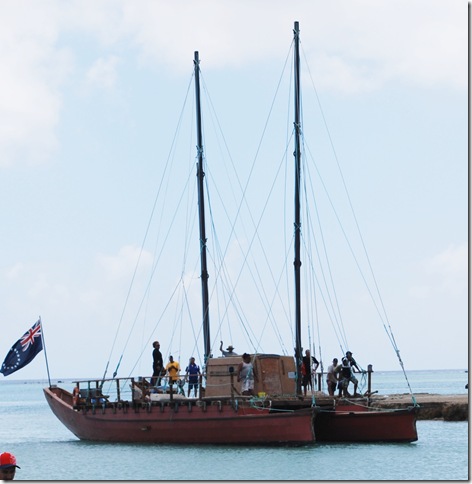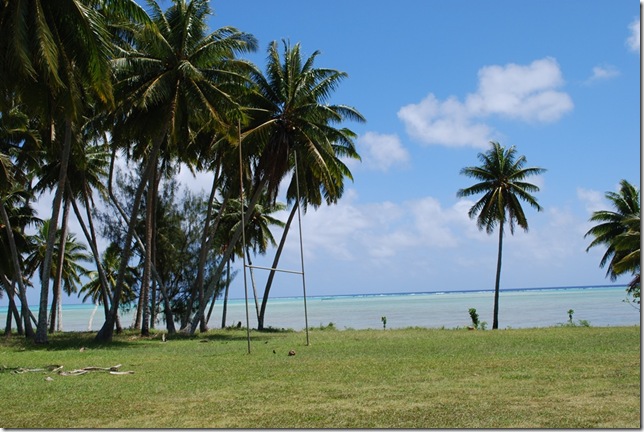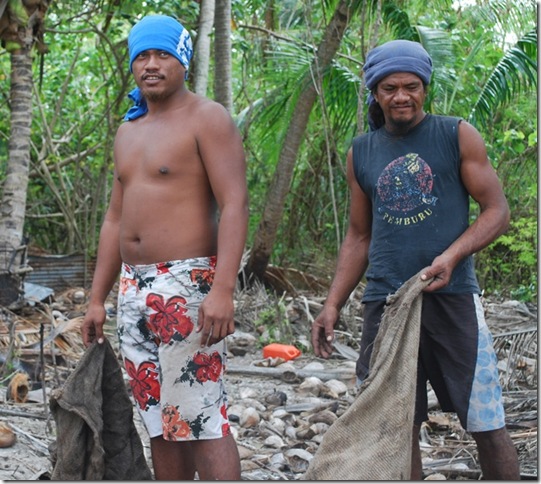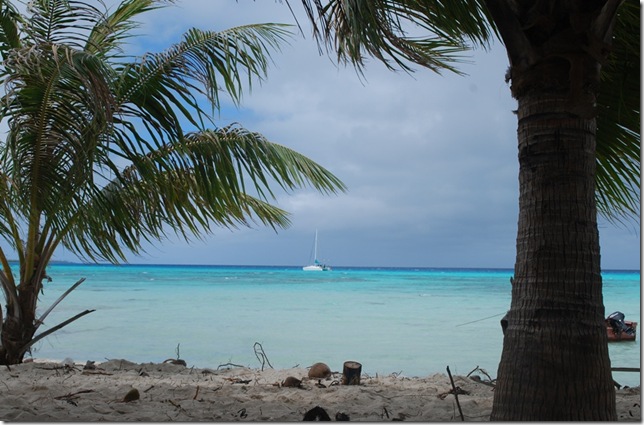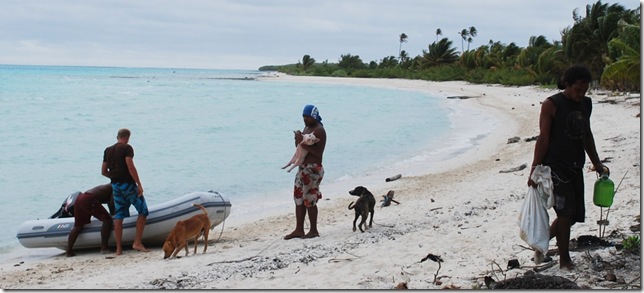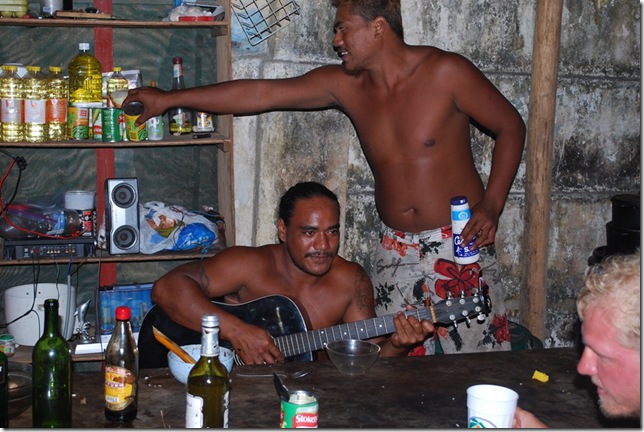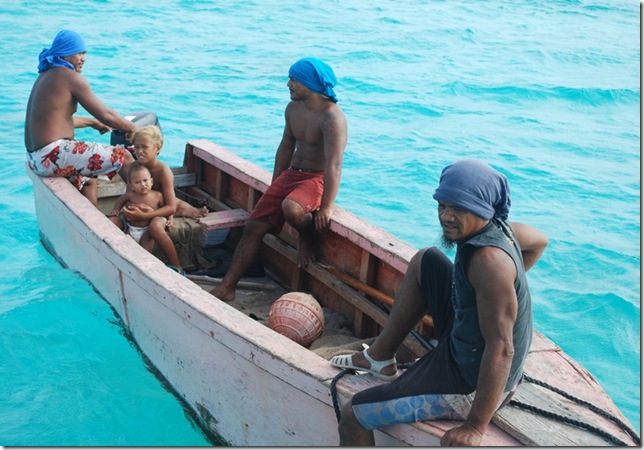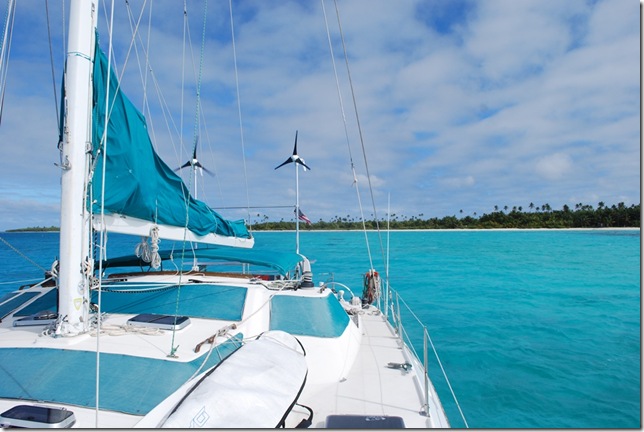Aitutaki has continued to exceed expectations, especially now that we have moved from the shallow spot in which we were anchored (and rubbing against the sandy bottom) to a sort-of quay on shore. Space became available on Saturday morning after S/V Dreamtime left. (Incidentally, they are 2 years into their projected 10-year circumnavigation and summed it up by saying, "Life definitely doesn’t suck.") We put out an anchor from the bow and had some help from Bruce on S/V Migration (from California) in getting our stern lines tied up to the coconut trees on shore. In doing so, Bruce cut his foot, but Tiff was able to put her nursing skills to use in getting him bandaged up.
Tied up to a coconut tree
After settling in, Dallas and I headed out on the bikes to further explore the island. First we stopped briefly at a hotel (Tamanu Beach) that has wireless internet for a reasonable price. Then it was time to hike up another mountain. At 500 feet or so, it was more like a hill. Unlike Bora Bora, Aitutaki is very nearly an atoll, as its volcanic peak has almost receded into the ocean, leaving only the large lagoon and surrounding coral reef behind. Anyway, the peak still provided an opportunity for photos of the brilliant aesthetic that we have grown accustomed to but certainly don’t take for granted. We had planned to have a picnic on the peak, but the combination of mosquitoes and heat was pretty unbearable, so we opted to eat while we walked back down.
The lagoon encapsulated by the reef
Next we rode up to the north end of the island and stopped at the Aitutaki Marine Research Center. There we found several small pools of clams of various sizes as well as a three-legged sea turtle, a few blue starfish (very cool), and a couple of my favorite fish that have camouflage on top and black and white stripes on the bottom. Apparently the research project involves preserving the population of clams and coral in the lagoon, but the researchers were in the middle of lunch, so we didn’t get the details.
One of the giant (1’ or so) clams
We tried to find a couple of art galleries on the north end of the island, but one was closed and the other no longer there. In the process of trying to find the latter, we stopped to ask a woman in her doorway for directions. Evidently they don’t get much tourist traffic on that side of the island, and as soon as she found out that we had arrived by boat, she offered us a bunch of papaya and bananas from her fruit trees that Dallas then learned how to knock down with a long stick. She and her daughter couldn’t have been any nicer, and they encouraged us to return for more fruit if we have a chance.
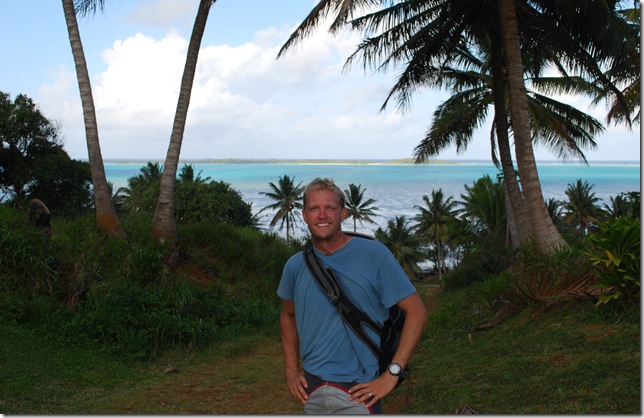 Dallas enjoying the beautiful day
Dallas enjoying the beautiful day
We ended our bicycle tour with a long ride around to the south end of the island to see the marae. It took a bit of luck to find it, as it is tucked away behind the waste management building without any signage. There is definitely less emphasis on ancient rituals and customs here than there was in French Polynesia.
We were pretty tired on Saturday night, but I always seem to have the energy to dance when there’s some good or even decent music playing. There is a restaurant/bar right here by the dock called the Blue Nun, and on Friday and Saturdays a DJ spins local and international records, so I stopped in to check it out. It was a pretty typical affair for the current MTV demographic (a "meat market", as we would say in the states), but they interspersed the American dance tunes with more traditional Polynesian ones.
Sunday morning we had a chance to experience one of the most prominent aspects of the current culture here in the Cooks by attending a local church. Dallas liked the look of one on the east side of the island that he had spotted during our bike ride, so we had a nice long walk over there during which we saw a number of locals travelling every which way to their respective churches. For as small as the island is, there are quite a lot of churches of various denominations, from Seventh-Day Adventist (we were going to attend their service on Saturday but had to move the boat) to Latter Day Saints to Jehovah’s Witness. We attended a Cook Islands Christian Church, and it was a good choice. After the initial prayer and greeting, the congregation broke out into song, and their acapella vocals were astounding. The older members seemed to be singing at the top of their lungs, and their clear, almost piercing tones reverberated off the vaulted ceiling. They sang in harmony (typically two-part) with beautiful intonation, and the song-leader seemed to switch according to the song. The Maori language is very similar to Tahitian in terms of there being a high vowel to consonant ratio, and their songs provided lots of opportunity for them to show off their pipes as they held out the vowel sounds. With the exception of the vocals that could rival the Vienna Boys Choir in terms of their quality, the service itself was pretty consistent with what I am used to in the states. The seating arrangement was a little unusual, though. Instead of sitting with their families, the younger women sat in the front showing off their pretty pandanus hats, and the men (those few in attendance) and older folks sat behind. The children sat on the sides, with the young girls chatting and teasing each other throughout. We could tell that the minister was quite an orator despite that most of the service was in the local Maori language. He took the time to greet the few of us tourists in English. He thanked us for making the effort to be there and said, "Convey our love to your friends and family back home, and tell them that Aitutaki is a good place for holidays." So there you go. 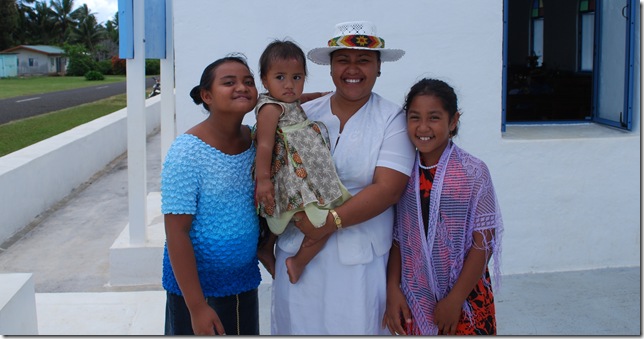
Showing off their Sunday best
On Sunday afternoon we watched a large, traditional wooden catamaran approach the dock. The Pacific Games are happening right now in Rarotonga, but the Hobie cat sailing competition is to be held here on Wednesday, so the catamaran is here to mark the occasion. We jumped aboard to check out their huge tiller up close. They have to hand steer all the time (3 hours on, 6 hours off), which we were told can be quite challenging and require more than one helmsman in bad weather.
Back on the boat, Dallas answered a radio call from our friends aboard Matajusi who arrived that morning. They are anchored outside the reef due to their deep draft and were curious about whether or not a shellfish that they found out there was edible. Dallas was eager to accommodate and found some local boys near the dock who agreed to go with us to their boat to see the shellfish and answer their questions. This was also a good opportunity for us to check out the dinghy’s outboard engine on which Dallas had just replaced the propeller in an effort to take care of the thrust problem. It turned out that the boys were quite knowledgeable about the local fish but got seasick rocking back and forth on the monohull out there, so it was a short stop, but before we left we saw a mother and baby humpback whale sounding in the distance. The outboard worked well on the way back until we were entering the pass into the lagoon, and even though the current wasn’t all that strong, it almost kept us from making our way back in and made a nasty sound when Dallas revved it. I guess the thrust problem is taken care of, but there is now a new, hopefully-related problem. Maybe the new prop just needs more grease…
Last night (Sunday) we went over to S/V Migration for a potluck that consisted of our homemade burritos plus Bruce’s jalapenos and salsa from Mexico (I couldn’t believe he still had them!) and his homemade pizza. It was quite a feast and quite good company as well. The Austrian guys from S/V Anima were really funny, and one of them led us in a sing-along of classics such as the Beatles of which everyone knew at least some of the words. He taught Dallas a number of songs and invited him over to check out his large collection of sheet music today. What’s more, he is currently helping Dallas to fix our broken escape hatch using his stainless steel welder! As I told him, he is a good guy to know.
Dallas just came back and informed me that I missed out on meeting the prime minister of the Cook Islands and the president of French Polynesia (as well as getting some free food) just now! Apparently they are here for a ground-breaking ceremony for a new museum to honor a man who had been declared dead after being lost at sea for 5 months, finally landing here on the reef weighing only 60 lbs! Talk about having will to survive. Anyway, as you may have gathered, there’s never a dull moment here in Aitutaki. I better wrap up and get back out there before I miss something else…
Ahhh. Every time we write about how beautiful someplace is, we go and move to someplace at least as incredible and we’re all out of fresh adjectives. The passage to Aitutaki, Cook Islands went reasonably well. Waiting for the weather paid off, and the wind consistently worked its way from near the beam to dead astern, with the seas eventually following and the motion improving. It did continue to blow pretty good, and we made great time with just the full jib up all the way. Aitutaki was in view when the sun came up Friday morning, just as we’d hoped.
Approaching Aitutaki from the north
We did have a couple of small adventures along the way. We have a pretty dry boat, and with all the downwind sailing of late, it’s been really dry. But after leaving Mopelia we had a large wave from the port beam that crested at just the right time to send the equivalent of several buckets of water flying over the deck and into the cockpit. We even had a gallon or so fly straight through the salon door onto the starboard settee. The area of the salon floor near there seemed to be staying wet for a long time, and the next day Tiff pulled up the rug, did a little investigating, and found that our escape hatch had broken and was letting water into the salon as waves smashed up against the bottom of the bridgedeck. The hatch is mandated by international safety regulations and is designed to allow you to leave the boat easier in the event of a capsize. We also joke that it’s our equivalent of the glass in the floor featured in the ultra-riche, over-the-water bungalows in Bora Bora. Unfortunately, the latch on one handle had broken and the piece that the handle latches to was missing on the other side. A 2.5 sq ft hole in the boat makes things a little wet when there’s a good swell running, so something had to be done. Even if we’d stopped the boat, we didn’t have all the replacement parts, and it needs to dry out to be repaired properly anyway, so after several futile attempts, I finally came up with a method of keeping it shut by tying lines from the handles to a point on the boat above it and then using screwdrivers to twist the lines tight. That was good for the last 200 miles or so. I think we have a spare latch on board, and we should be able to work something out for the other side while we’re here.
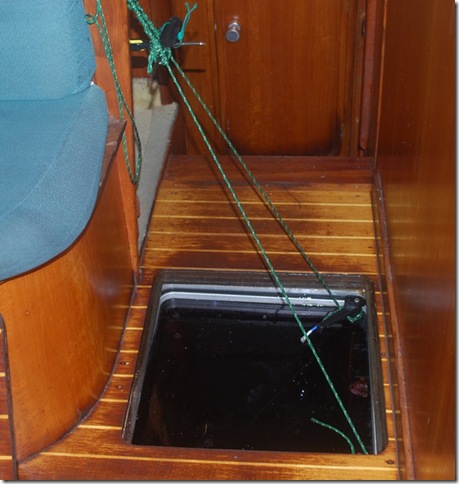 A little line, a couple screwdrivers,…
A little line, a couple screwdrivers,…
The pass and anchorage in Aitutaki makes the pass in Mopelia seem trivial. The pass here is just as narrow, but man-made, longer, and much shallower. We took our time getting in and anchoring in a tight spot with less than a foot of water under the port keel. We thought we understood from the boat beside us that the tide was low, but it wasn’t, and the port keel is now bumping occasionally. Luckily the bottom underneath it is sandy, and the rudder is in enough water, so we’re fine. Tomorrow there’s a boat leaving the sort of quay nearby, and we’ll move in to tie stern-to with an anchor out and lines run to palm trees.
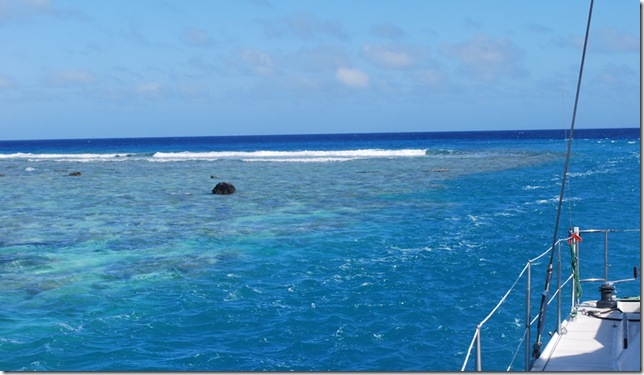 You can see how close we are to the edge of the pass as well as the churned-up water
You can see how close we are to the edge of the pass as well as the churned-up water
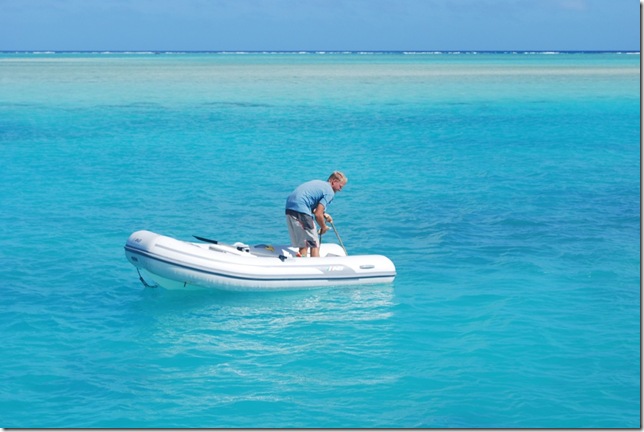 Setting a stern anchor amid a palette of blues
Setting a stern anchor amid a palette of blues
The island itself is an almost-atoll, which means it’s mostly an atoll (motus & lagoon) but also has a low (max height maybe 250 ft) main island that is inside the lagoon. Evidently the lagoon here is world-renowned for it’s beauty and landed Aitutaki on one of those US “places you must see before you die” lists. The Cook Islands are now an independent nation in free association with New Zealand, which basically means that New Zealand subsidizes the government budget and is ultimately responsible for Cook Islands foreign affairs and defense. We were a bit surprised to see several boats filled with Kiwi tourists heading out for lagoon excursions not too long after we’d set the anchor.
We got an earful of how great this place is from S/V Dreamtime on our way in, and by the end of the day we agreed. For starters, they speak English. We’d been in French Polynesia so long that we’d really become accustomed to getting around with a limited vocabulary and ability to understand things. It’s so much easier to get around and get things done when you’re fluent in one of the local languages. Dreamtime warned us that the customs guy was not in today and the agricultural inspector would seize all of our fresh fruits and vegetables, so we radioed back to the boat to give Wes and Tiff a heads-up so they could eat or hide them. The policy appears to be partly due to the association with New Zealand, which is also very strict, and partly due to their wanting to keep the islands as they are, relatively free of pests and plant diseases. That’s fair enough.
The woman at the harbor master’s office couldn’t reach anyone on the phone for us to check in with, but both the health and agricultural inspector found us at the same time while we were checking out the town. The health inspector had the form with the same questions that are asked at every port (has anyone died? any cases of cholera or plague? etc.) Cruise ships do occasionally have bodies on board, but for a small yacht they’re always funny questions. He got a laugh out of how quickly I was able to answer no all of them. The agricultural inspector had his kid with him and was in a bit of a hurry. At first, he insisted he’d have to come on board since we may have some tomatoes and a pamplemousse. When I told him Wes and Tiff were eating the pamplemousse for lunch, he eventually gave me a nudge and said “None” in reference to the form. Good enough for me. It was $20 NZ for each inspector and before I let the agricultural inspector go, I said “One more thing.” “Yes?” he asked. “How do you say hello in the local language?” We both just started laughing and laughing. All this business about tomatoes and he hadn’t bothered to say hello. “Kia Orana” is the answer, which sounds almost identical to the “Io orana” used in the Society Islands.
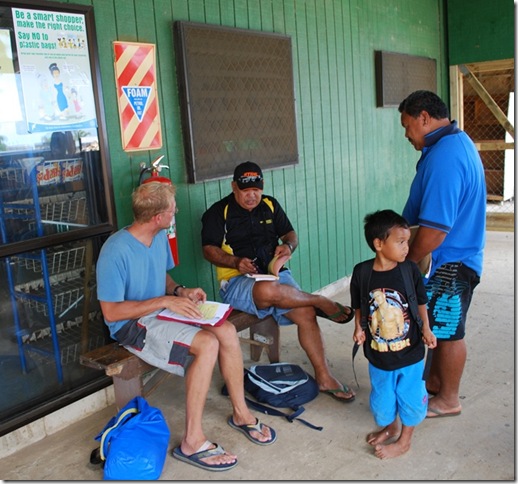 The health and agricultural officers caught up with us at the gas station
The health and agricultural officers caught up with us at the gas station
We spent some time walking around the island, finding an internet connection, and enjoying the beautiful island and weather as well as the friendly people. It’s not a rich place, but they seem to do a reasonable tourist business, things are generally well-kept, and the people seem good-natured. We were able to change the bond money we got back in Polynesian francs into New Zealand dollars, which was interesting, as the teller didn’t seem to comfortable with the calculator and exchange rates. Luckily the manager was there and everything worked out fine. The walk back to the boat was shortened by a cool guy who saw us walking and gave us a lift in the back of his truck. Almost everyone here is either on a scooter or riding in the back of a pick-up (the guy that picked us up had a 2×6 bolted in as a seat in the back of his pick-up).
For now, we’re just feeling lucky to be anchored in another beautiful lagoon enjoying the sunset by an island with friendly English-speakers and all the necessities (possibly including propane as well).
Lat: 16 58.034′ S
Lon: 154 30.101′ W
We were awakened yesterday by shouts of “Hello, Bonjour!” I scrambled out to the cockpit and found the guys from the atoll approaching in their boat. They brought four lobsters and three small parrotfish for the second pack of cigarettes. They also asked about some cookies for the kids, but Lauren and I wanted to go ashore anyway, so we told them we’d be in later with some more things.
During breakfast, we downloaded a GRIB file and saw that things would be more pleasant for us offshore if we waited another day to leave, which was just fine with everyone after getting tossed around a bit on the way over.
Mopelia is obviously quite isolated and the mode of life simple, so we tried to pack a decent bag of stuff for them — a couple of shirts, a good pair of work gloves, candles, tea, candy and ribbons for the kids, canned corned beef, WD-40, and some fresh cookies Lauren had made. It’s really nice to be able to give things to people in places like this. When we got ashore, we found a couple of them working on copra by prying the meat from the coconuts. We made introductions and found that this part of the island was inhabited by Kalami (22), his wife Sophie, their two boys (one year and one month, respectively), Kalami’s male relatives Bako (33) and Ruta (25), and an 11-year old son of a friend. They offered us some “locale/Tahitian biere” (did I mention it was 10 a.m.?), which is a concoction they make from rain water, sugar, and yeast. It was very drinkable (tastes like a strong, slightly sweet white wine) and we sat down on a couple of burlap copra sacks to chat. The guys in their 20’s looked about as old as Lauren and I, and at 33, Bako would have passed for a grizzled 48 back in the states, but they were friendly and laid-back.
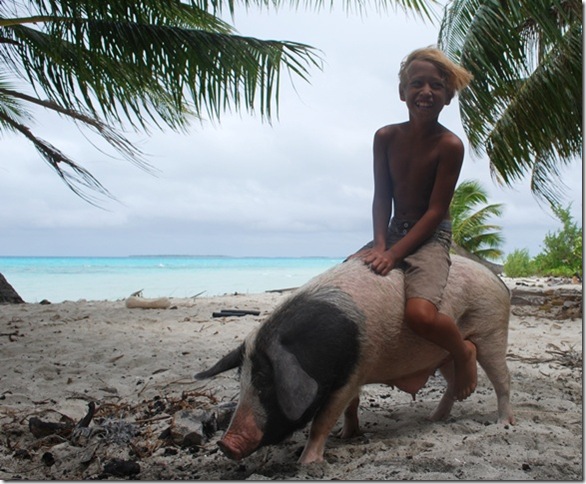 Yes, a pig does move along rather quickly when you reach back and slap it on the behind
Yes, a pig does move along rather quickly when you reach back and slap it on the behind
We were talking on the beach, looking out over the lagoon and at Pura Vida at anchor when it started to sprinkle and we all headed to the house. The house is sort of what you see on television when Sally Struthers is trying to get you to send money to save starving kids. Part of the building was old concrete, but the roof and places that had an outer wall were corrugated tin. There was only one partial inner wall made from a variety of materials that separated the area where Kalami and Sophie sleep. Interestingly enough, they have a couple of solar panels, a deep-cycle battery, and a couple of portable DVD players that also play music as well as an old amp and one above-dash automobile speaker. They were interested in having us burn some CDs for them (UB40, Bob Marley, Bon Jovi, etc.) and before too long they decided we should have a party that night.
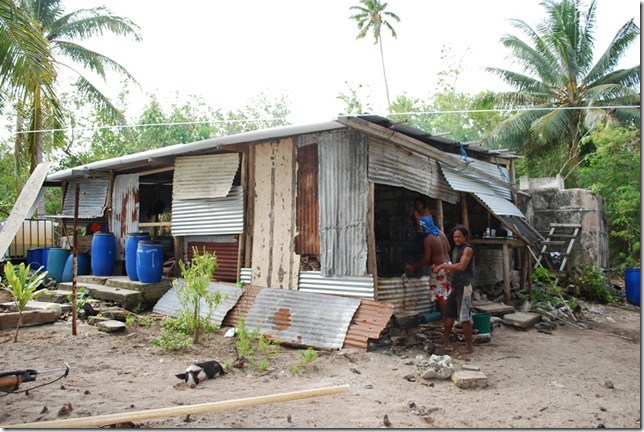 The casa (one of three on Mopelia)
The casa (one of three on Mopelia)
There was another boat anchored out on the reef, and the plan was to invite them to the party as well. The first step was go see Kalami’s Dad to pick up a small pig and some local beer for the party. Ruta and I drew pig and beer-fetching duty, and we headed out. I learned on the way that this meant a boat trip to the far south of the island. As they don’t have much fuel, we were to go in our dinghy. That was no problem, but the dinghy engine has slowly been losing power, and it wasn’t doing well at all. It turns out Kalami’s dad lives at the other end of the atoll, about 4 miles away, and we couldn’t get much above idle power. For some reason, you can rev the motor up, and the prop spins, but there’s no thrust. That’s not covered in the service manual’s two pages on troubleshooting, so it’s going to be a project. Anyway, we eventually decided to turn around and swap boats as we were getting nowhere, and I didn’t want to get stranded.
On the second attempt, we put Kalami’s engine on our dinghy, and we eventually made it. The boat that was anchored out on the reef turned out to be one of the boats we met in Bora Bora, and they were now anchored in the beautiful, peaceful area at the south of the atoll. Ashore, Ruta said hello to Kalami’s parents and set to work. Their place is almost too much to put into words, but imagine a stereotypical rural Appalachian or Arkansas one-room shack, all sorts of modern and primitive items strewn about the yard, a couple of large copra-drying racks, and numerous pigs, dogs, and ducks (first time to see them here). Now superimpose that on a beach and lagoon that Club Med would be drooling over if it wasn’t on an atoll in the middle nowhere. Kalami’s Dad was a chubby, amiable fellow with a big head of curly hair who wore a T-shirt and pair of briefs/speedos, which passes for casual wear on the atolls and takes a bit of getting used to. First, we grabbed a couple of pigs and tied them by the leg to a hammock near the beach. One was larger than the other, but both were small and white. We also grabbed a sort of grill to cook the pigs and Ruta filled the bottles we brought with the local beer. Kalami’s Dad makes the stuff in a big water barrel and also had some bananas in this batch. In typical island style, the bottles are any glass bottle or jug that’s been left or found, especially wine bottles. For corks, there’s a type of foam fishing buoy hanging from the re-bar protruding from the roof that can be cut and stuffed into the neck of the bottle.
We loaded the pigs, grill, and a pretty fair amount of the “locale biere” into the dinghy and finally arrived back several hours after we’d originally left. I’d inadvertently left Lauren there for several hours, but she managed well, getting to know the family. They receive a visit from about three trading boats a month from nearby Maupiti. They keep a number of pigs and there are also wild pigs on the island, so they trade pigs for cigarettes, baby food, and other commercial goods. They also get about 3 cruising boats a week during the season (an additional item we picked up at at Kalami’s father’s place was a guestbook filled with entries from visiting yachts). There’s essentially no money on the island, and they prefer the subsistence and trading existence to the monetary and labor economy. They have plenty of fish and meat, and grow a few vegetables as well. Lauren also learned how to make coconut milk, which has been something we’ve wanted to figure out. The key is to get a young coconut and the proper tool. They use a device that looks like a paddle with a scraper at the end of the handle. You sit on the fat part and use the scraper between your legs to clean the soft meat from a young coconut. The meat can then be wrung out using a cheesecloth to produce the milk that’s used for dishes like poisson cru.
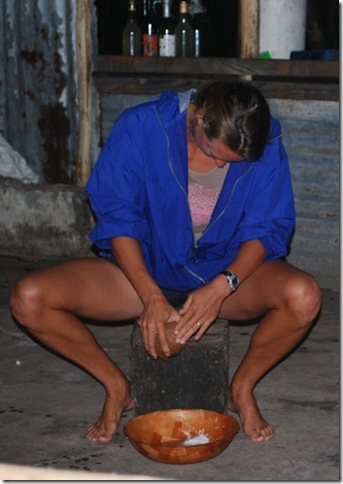 Lauren grating the meat out of a young coconut
Lauren grating the meat out of a young coconut
Dinner that night consisted of barbecued ribs, poisson cru, rice, and a second pork dish (I’m not sure which pig was ribs and which was stew, but Lauren says they were both good as long as someone else is doing the presto-change-o). For me, they even broke out a can of corn. Before we could get started eating, though, we had to make a quick run back to the boat for place settings for Lauren and I. As they were drinking from old wine bottles and bowls it doesn’t appear they have cups, and they didn’t have any extra plates or forks. No worries, as we’d forgotten my guitar as well.
After dinner the singing started. It turns out Ruta is an incredibly good guitar player even though he doesn’t own one and hasn’t touched one for 5 months. In addition to Tahitian and French songs, he played Bob Marley, Metallica, improvisations, and did some pretty impressive picking. Everybody joined in, and Ruta even got me to attempt some improvised vocals, which isn’t something you’ll be hearing anytime soon. There were songs about everything from my love / mon cherie to Jacque Chirac, to the moon and the pass, but Lauren and I almost died laughing when they all of a sudden started singing the French version of Hakuna Matata from the Lion King. Ruta was pretty impressed with the guitar and offered all the lobster in Mopelia for it. Unfortunately, I’m a vegetarian and we don’t have a freezer now, so we all had a good laugh at that being unfortunate for him. Because of the issues with our motor, Kalami and Bako took us back using their boat at the end of the night. The route is littered with shallow water and large coral heads, so we used a large light we had and left it with them to get back safely.
This morning, Kalami returned with the light and guestbook for us to sign (they hadn’t had a pen at the house the night before) and I gave him a few more things, including a low-power, guaranteed-for-life LED light that should help out a bit in the home lighting department. It seemed like we were both sad to say goodbye, but such is our life. The sun had come out and the wind had lightened up a bit, making our weather planning seem worthwhile. Tiff cooked up the lobsters and we enjoyed lunch before pulling up the anchor and motoring across the lagoon.
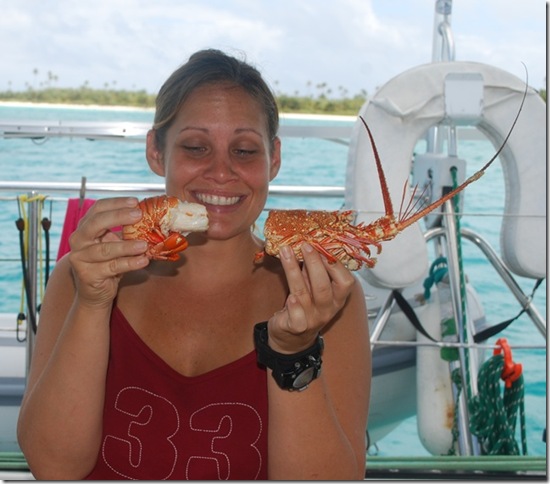 Et Voila! 1/4 of a pack of cigarettes worth of lobster
Et Voila! 1/4 of a pack of cigarettes worth of lobster
This place is so beautiful that we all just sat on deck and watched silently as we made our way toward the pass. Before we knew it, we were through the pass and out into open water. Tiff pulled down the French courtesy flag, and our visit in French Polynesia officially came to an end. It was a wonderful last stop and one that we’ll remember for a long time. Lauren looked through the guestbook and noticed that several boats had returned to Mopelia a second time after several years, and there’s no doubt we’d do the same if we came this way again.
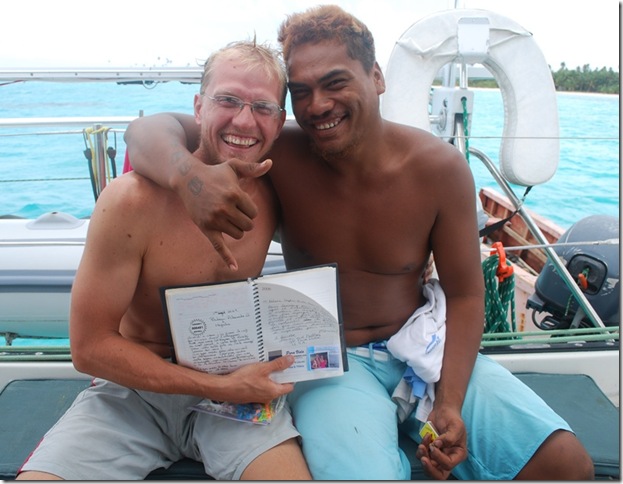 Our page in the Mopelia guestbook
Our page in the Mopelia guestbook
The seas are still up a bit, but not as bad as they were, and the sun is out, making it a beautiful day for sailing. We’re using just the jib again and are averaging above 5 knots with no problems.
Lat: 16 46.738′ S
Lon: 153 56.869′ W
Lauren and I started our last full day in Bora Bora with a snorkel trip to the “coral garden” around the point. I stayed at the surface on account of my ear, which has shown no improvement, but was able to enjoy things nonetheless. The coral wasn’t much to see, but there were a lot of colorful smaller fish that are evidently used to being fed, as many of them swarmed around us. There were also several schools of a light-colored fish that were laying in groups on the bottom, like they were having an afternoon nap. I’m still a little bummed about being diving-disabled in Bora Bora, but as Dr. Duval pointed out, I can’t complain too much, as there should be plenty of other dive opportunities.
Next we headed into town to do some shopping, including buying duty-free diesel, one of the few reasonably priced items to be found here. When we got to the fuel dock in the dinghy with our fuel jugs, we found a boat from the anchorage we’d just left along with a friend of theirs with a dinghy full of fuel jugs. The woman’s first question to Lauren was, “Does Dallas have the correct papers for the duty free fuel?” Evidently we’ve been fortunate in that even though the authorities in Papeete were feuding as I stood there, they managed to give me all the correct papers, unlike some other people we’ve meet. The other cruisers at the dock were missing one of the 4 papers that are required (the duty-free diesel permit alone isn’t enough), so I ended up using my papers to buy fuel for all of us.
Next we were off to the marine store to pick up a handheld VHF. One of ours was stolen from Lauren’s backpack in the Galapagos (where they retail for about $400) and our second one just died, which makes sharing a dinghy a little difficult. We also made the obligatory stop at the grocery store to stock up and grab some snacks and stopped at the hardware store for some boat project items.
Duty-free diesel is only about $3/gal, which feels like next to free, so the next morning, after topping off with water and emptying trash at the Bloody Mary’s dock, we headed back to the fuel dock to fill our jugs again, as all the diesel we’d bought the day before had been put into the tanks. This was our third visit to the gas station, and the woman who was a bit short and speaking French-only the first time we came and didn’t have enough cash was now very friendly, broke out reasonable English, and volunteered to combine our diesel purchases from the last couple of days so we didn’t have to do more paperwork. It really helps to smile and know how to say hello in the local language (“Yo-rana”). Our diesel tanks are now topped off and we have extra fuel in the jugs.
There are a couple of things I thought were interesting about Bora Bora that haven’t made it into a blog yet. One is that having reached the end of French Polynesia, we have yet to see a Polynesian wearing eyeglasses. We asked Moana about it in Ua Pou and he seemed to indicate that Polynesians had genetically good eyesight. I’ve mentioned it to another cruising couple and they couldn’t recall ever seeing a Polynesian with eyeglasses either. Another thing that seems to be unique to Bora Bora are go-fast boats with a complete disregard for anchored sailboats. The private boats and dive boats will buzz through an anchorage at a pretty high speed, sometimes within one boat length of anchored boats, which gets a little frustrating if you’re in the water working on the boat or in the middle of something that doesn’t like to be shaken up. Apparently because of all of the clear water and visible rocks and coral heads, the speedboats here have a unique design. Instead of sitting in the back of the boat, the driver sits on a seat in the bow of the boat and steers with a lever that moves left and right. Presumably, the forward helm station makes it easier to see the path that should be steered, but it’s the first time I’ve seen a design like that.
We weren’t the only boat that picked this window to leave. The VHF was crackling with boats hailing each other to check on conditions, arrange radio rendez-vous, and wish each other good trip. As we headed out the pass and set our sails, we could see at least five other boats heading out for different points west. Even in a gathering spot like Bora Bora, that feels like a virtual armada of cruising boats setting out.
We set a course for Mopelia, a small atoll we learned about from Jerome and Antoine while we were in Kauehi. It has the narrowest, supposedly most nerve-wracking pass in French Polynesia and is inhabited by between 3 and 20 people at a time.
The weather forecast called for moderate winds, followed by shifting light winds, before filling in from the southeast. Everything worked out as forecast, but we got a bit more wind and steep seas on the beam than we were expecting after things filled in during the early morning hours. Lauren did a good job on her watch of stowing all of the fuel and water jugs that had been sitting on the side decks and doing their best to jump overboard when things started getting rough. All of us pretty much stayed horizontal unless we had to get up, but nobody got sick enough to do any fish feeding. With her typical iron stomach, Lauren of course managed to do a bit of cooking (telling me later about picking the dead weevils out of the pasta) and some reading.
Between motoring in the light winds and doing 6 knots on just the jib when the wind picked up, we made the 128 nm run to Mopelia in time to attempt the pass at an ideal time, with the sun at our backs to make it easier to see and avoid coral heads. For the first time ever, our Navionics charts were off. When I lined up to head into the narrow, churning pass, the charts showed us going straight onto the reef, with the pass off to port. Oh well, this isn’t exactly a hotbed of yachting activity and you’ve got to trust your eyeballs, especially with a pass like this. The pass has quite a reputation, and it is narrow (maybe 60 ft or so and we have a beam of 21 ft), with lots of current (we got lucky and only had about 3-4 knots or so) and jagged coral rock edges, but it’s deep enough, and we made it through only a few tense minutes after we made the irreversible commitment to go for it. Lauren and Tiff each kept a look out for rocks from the bows and I kept busy with the throttles up and the wheel spinning back and forth as each refracted wave tried to turn the boat.
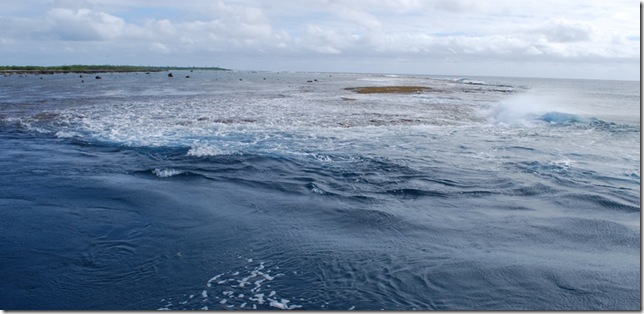 Current, rocks, and small breakers entering the pass
Current, rocks, and small breakers entering the pass
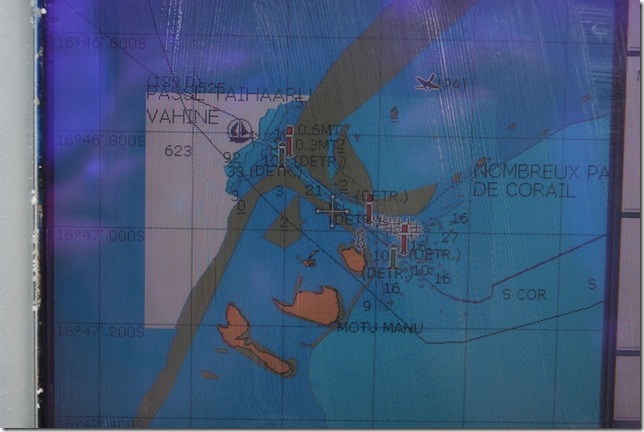 The bottom track shows the actual pass location
The bottom track shows the actual pass location
The atoll itself is incredibly beautiful. It is just a bit larger than 3 miles by 4 miles and sets NNW-SSE along the long axis. It has several motus, including a very large one that makes up the eastern side of the lagoon. A couple of the motus have small raised hills with greenery and coconut trees, while nice sandy beaches, and turquoise and soft blue water are everywhere. From our anchorage here on the northeast portion, we can see the spray thrown high up into the air as the swell crashes on the southern fringing reef 4 miles away. One of the motus is supposed to be a bird nesting site and the boat was surrounded by about a dozen large sea birds circling and swooping down near us as we approached the atoll.
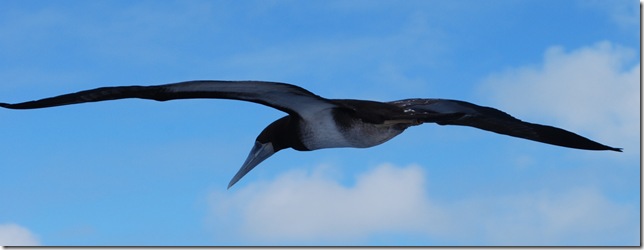 These guys were everywhere on the way in
These guys were everywhere on the way in
By the time we’d anchored and gotten settled, it was getting a bit close to dark for a shore visit, but we could see pigs wandering on the beach near a shack and home-built boat. Before long, a couple of guys got into the boat and headed our direction. They slowed near our stern and handed me two gutted, ready-to-eat parrotfish in a pan. The boat they came out on was a long and narrow home-built work boat with an outboard motor. Mounted on the bow was a nice sailing winch that they’d salvaged from a catamaran that is apparently wrecked on the reef near the pass. We’d heard that supply ships are pretty scarce here and that cigarettes are highly valued. Although none of us are smokers, Lauren and I had picked up a couple of packs before leaving Bora Bora. You should have heard the yelling and hollering that broke out when I told them we had cigarettes to trade for the fish. It was like they’d won the lottery. Tomorrow morning they’re bringing out lobster for the second pack. We asked how many people lived on the island, and they said two families. When we asked how many people that included, there was some finger-counting, a sort of confused look, and then we moved onto the next question.
Tiff did a great job preparing and cooking the fish, and we incorporated it into a fish burrito dinner that Wahoo’s would be proud of. There’s only one light on the island, barely visible for a couple of hours after sunset, coming from the dwelling on the beach that we saw earlier today. Other than that, it’s an overcast night and it would be hard to tell we were anchored all alone in a lagoon at all just by looking around.
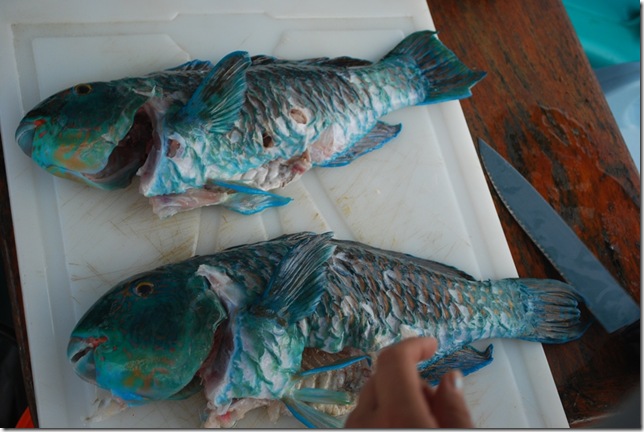 Parrot fish (in addition to the colors, the mouths really are like beaks)
Parrot fish (in addition to the colors, the mouths really are like beaks)
We’re probably headed out tomorrow to try to get to Aitutaki by the weekend, but this is definitely one of those virtually untouched places where it’s easy to linger and just take in the peace and natural beauty.
Yesterday morning Tiff and I went scuba diving a mere few hundred feet or so from where the boat was anchored. We had seen multiple dive boats in a particular spot tied to a moored dive boat, so we assumed that there must be something there to see. Despite that it was close by, getting over there was a comedy of errors. The current was intense and rapidly carried Tiff and I away from the boat, in the opposite direction of the dive site. We agreed that it would be best to get a lift over in the dinghy rather than trying to swim there, but even at the lowest possible speed, riding alongside the dinghy was a bit of a nightmare what with water flowing over our heads so that we couldn’t see or breathe, so I had to stop being stubborn and allow Dallas to drag me and my 40 lb gear into the dinghy for the 2 minute ride. Then as he was pulling Tiff into the dinghy, I lost my balance and fell back into the water and had to repeat the process. Needless, to say, Dallas got more exercise than he anticipated when he volunteered to give us a lift.
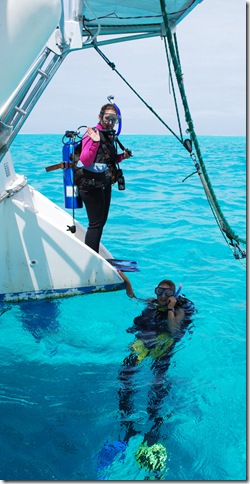 Check out the clarity of the water!
Check out the clarity of the water!
Once at the dive site, we quickly sank to the shallow bottom (around 12′) and found ourselves drifting back toward the boat super fast. We had to kick like mad to stay near the coral heads, but we must not be the only ones who have had trouble with this, as we found ropes tied between the coral heads to grab onto. These kept us from immediately floating back to the boat and thus having a very short dive. We held the ropes as we explored four large coral heads and the surrounding fish. The most common ones seemed to be zebra fish, needle fish, schools of small vibrantly blue ones, and black, white, and yellow angelfish.
Dallas had suspected that this was one of the sites where sharks or rays are fed for the tourists, who use long hoses attached to a small tanks of compressed air that remains on the boat to breathe underwater. While we didn’t see any tourist boats arrive while we were at the site, we are pretty sure that Dallas was correct, as we had two very large (about 4′ across) gray stingrays circling around us for at least 10 minutes as if we were supposed to feed them! Under other circumstances, both of us agreed that we would have been pretty freaked out by this, but it helped that we had heard about the feedings and the rays’ apparent comfort with people. Even so, we didn’t expect them to get SO close, and when one of them approached Tiff almost seeming to want to kiss her (it was only a few inches from her face), I instinctively grabbed her and pulled her away! She later said that her instinct was to freeze up and pretend she wasn’t there!
After about half an hour, we had seen what we wanted to see (and I was low on air, as I was using what remained from Dallas’ dive on our anchor in Huahine), so we rose to the surface. We blew our whistles to get Dallas’ attention, but the boat was upwind of us, so that didn’t work. Dallas had said he would be checking for us every five minutes, but Tiff and I decided to use the formidable current to help propel us back to the boat. About two minutes later, we were there!
We talked over our plans for the day and decided to try to motor over to a nearby anchorage. Dallas and I used the dinghy and depth sounder to confirm that we could make it there without running aground on one of the many coral heads. While it was very shallow (as little as 6′) in some places, it looked like we would be fine with our 3.5′ draft, and we were. We were surprised to see some monohulls in the anchorage, though.
A French woman from one of the monohulls came by and invited us to her 4-year-old daughter’s birthday party on the beach. She was a little disappointed that we didn’t have children to attend the party, but she later found some local kids on the beach to invite. Tiff and I decided to go, and we really enjoyed the company of the small group of cruisers in attendance from France, New Zealand, Columbia, and Switzerland. We drank some rum, played with the bilingual kids ("will you play avec me?"), and I even had the opportunity to play "Happy Birthday" on the Swiss mountain horn. It seemed that a good time was had by all until the end of the night when we were reminded how difficult it can be to sustain positive relationships on the close quarters of one’s boat. One couple had a very public but controlled argument before heading back to their boat, while another got into a loud, intensely emotional fight back on their boat. We were anchored some distance away, but we could clearly hear what was going on, and it was all I could do not to jump in the dinghy and try to calm them (particularly the woman) down. Just when we thought the situation had subsided, we heard a splash and realized that the woman was in the water swimming toward shore with the man following behind in the dinghy, trying in vain to get her aboard. At this point Dallas agreed that it was time to intervene, and we picked up the woman in our dinghy and housed her for the night (after Dallas retrieved some dry clothes from her boat and had a good chat with the man). The next morning she was gone, and we haven’t heard anything since, so we are assuming it was just a case of too much booze. After spending time in less inhabited, very tranquil anchorages, we are not used to such drama!
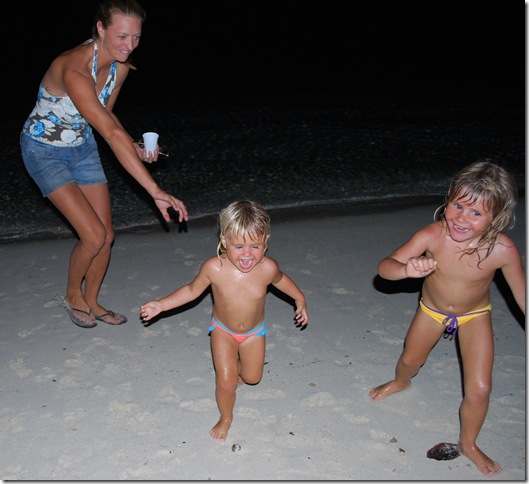 Chasing the birthday girl and her sister
Chasing the birthday girl and her sister
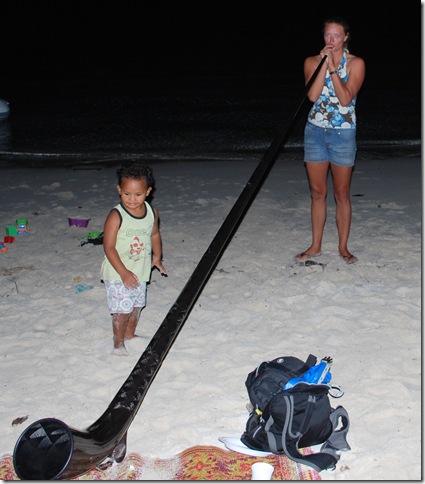 Pulling out the collapsible Swiss mountain horn was a great party trick
Pulling out the collapsible Swiss mountain horn was a great party trick
Yesterday was much less dramatic. Wes and Tiff took the dinghy to go snorkeling, Dallas did some boat work (sewing a tear on the spinnaker, repairing a broken starter rope for the outboard engine), I baked some banana bread and went snorkeling around the anchorage, and we Skyped with friends and family.
Last night Dallas and I had dinner at "Ben’s", a "snack" (small, informal restaurant) on the road that runs along the beach. Ben is from Bora Bora while his wife is from…wait for it…Oklahoma! They have been running the snack for 20 years and have a lot of insight into the island and its social problems. It sounds like Bora Bora is anything but paradise for the locals. For example, there are few jobs beyond those in the tourist industry. The best of these go to the French, and the mid-level jobs go to Tahitians and other islanders, leaving only 15% of the jobs (the menial ones) for natives of Bora Bora. To top it off, public service companies such as the electric company have a monopoly and are increasing their rates just as the island has fallen into an economic crisis. As happens anywhere, these economic problems coincide with mental health problems, and Ben and Robin are currently in the process of adopting a boy with an alcoholic father and a remarried, negligent mother whose elderly foster mother physically abused him. These were harsh realities to consider, but it was enlightening to get the local perspective of the island, as this was our first opportunity to do so in the Society Islands (in English as well!). Incidentally, we also learned that Marlon Brando’s wife, who he met during the filming of Mutiny on the Bounty in Tahiti, had no teeth until she was given a new set by MGM Studios! Unfortunately, Marlon’s outrageous fortune did not prevent them from having outrageous problems, and for those who don’t know, his son was later imprisoned for murdering the abusive boyfriend of his sister, who later committed suicide. Talk about drama!
After all of this, we are feeling ready to get back to the peace and quiet of the sea. Today we will get duty-free diesel, do some last minute snorkeling, and prepare to get underway tomorrow.


